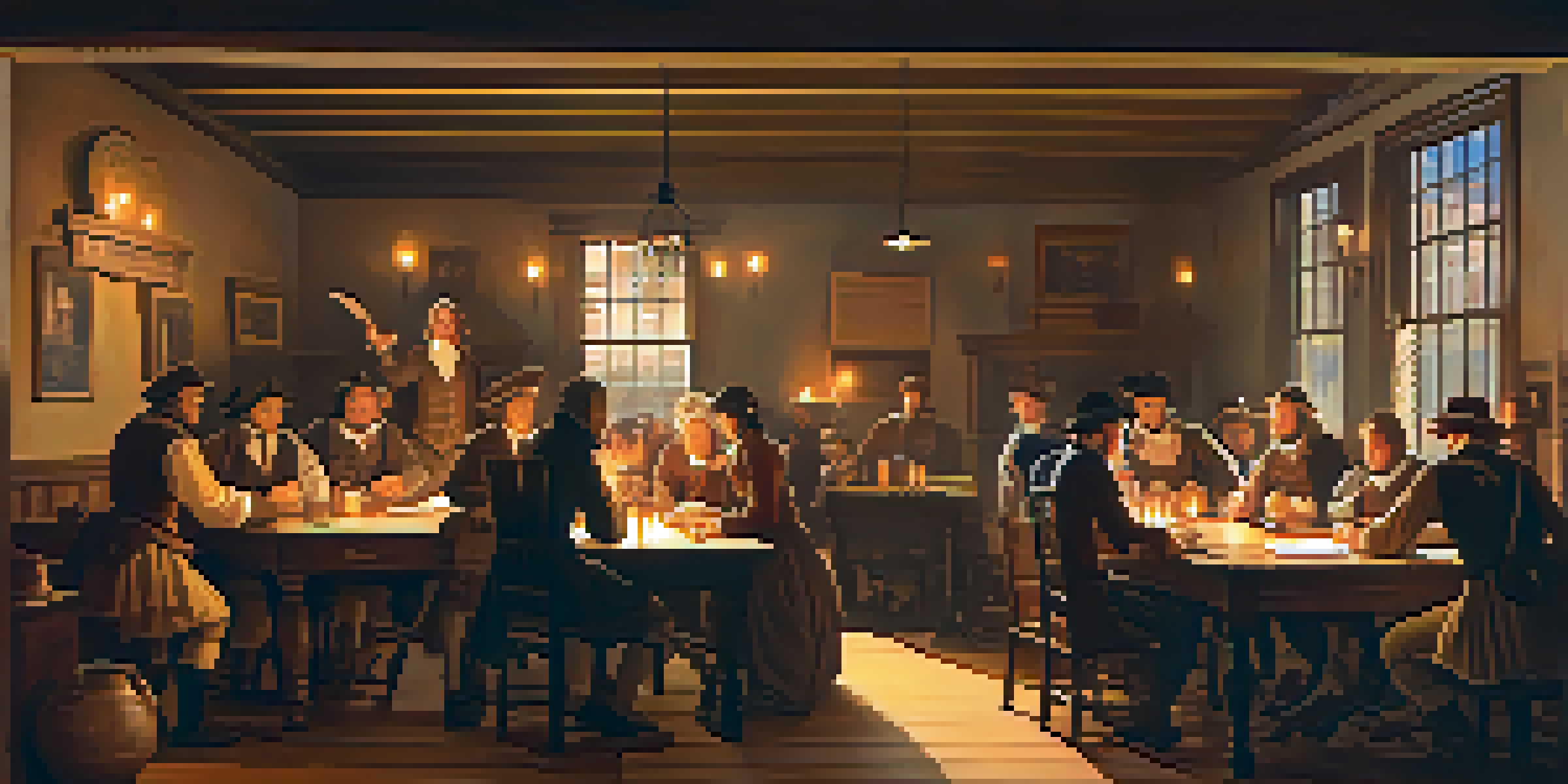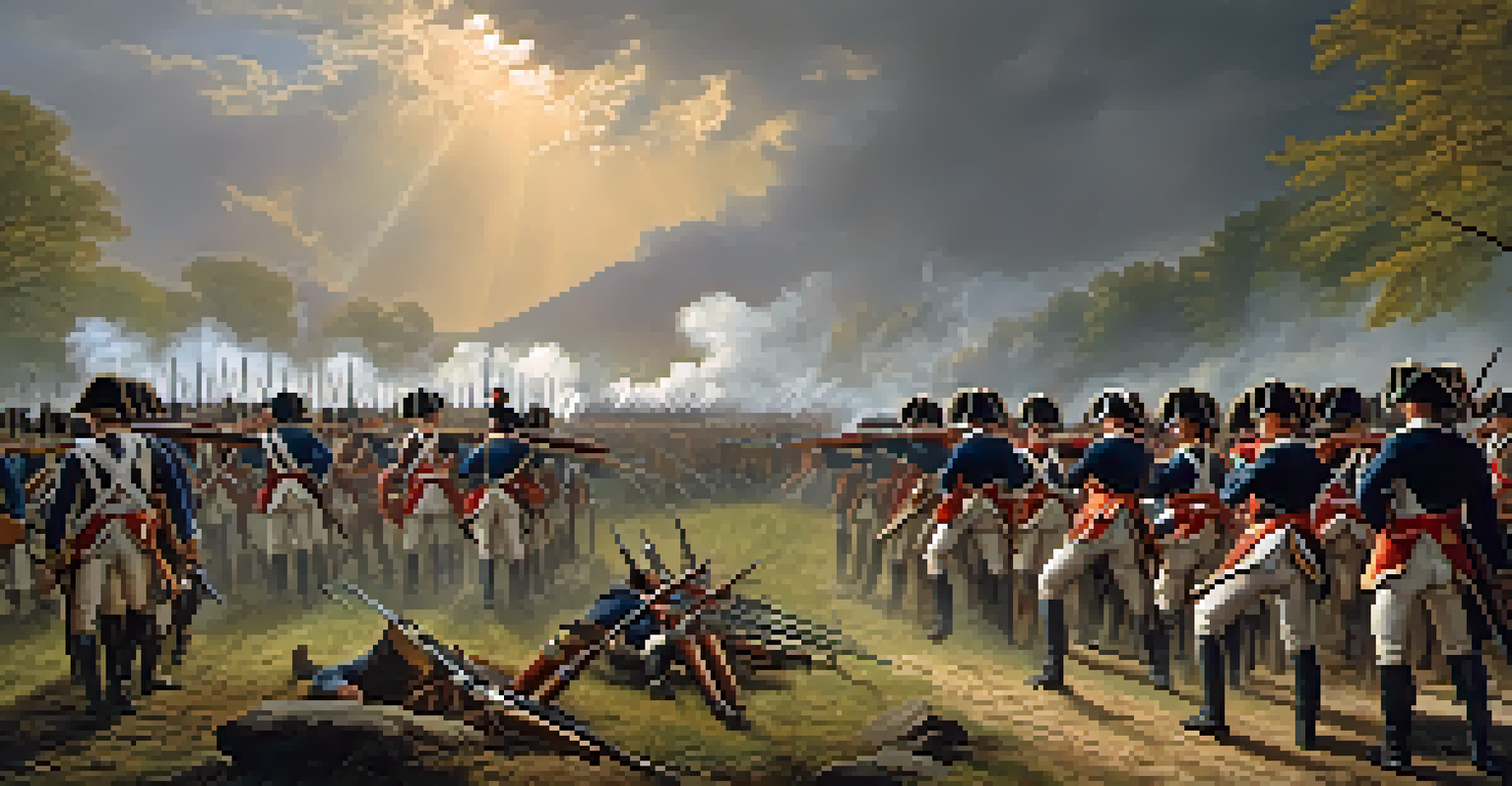The American Revolution: NYC's Role in the Fight for Freedom

The Prelude: Tensions Rise in Colonial NYC
In the years leading up to the American Revolution, New York City was a hotbed of tension. Colonists were increasingly frustrated with British taxation without representation, sparking debates in taverns and town halls. Events like the Stamp Act of 1765 and the Townshend Acts fueled a growing sense of unity among the colonies. New Yorkers were not just passive observers; they became actively engaged in the fight for their rights.
Liberty, when it begins to take root, is a plant of rapid growth.
As protests erupted, the famous Sons of Liberty emerged, and New York became a center for revolutionary fervor. These groups organized boycotts of British goods, calling for a united front against oppressive legislation. Their gatherings were often lively, filled with impassioned speeches and a shared vision for a free America. This atmosphere of dissent laid the groundwork for the larger conflict to come.
The tensions culminated in significant events, such as the Boston Tea Party of 1773, which further galvanized support for the revolutionary cause. Even though the Boston Tea Party occurred in Massachusetts, it resonated deeply in New York, showcasing how interconnected the colonies were. As the call for freedom grew louder, New York's role as a center for revolutionary activity became undeniable.
The Spark: NYC's Role in the Initial Conflicts
As the American Revolution began, New York City quickly became a pivotal battleground. The first shots of the conflict were fired in April 1775, but it was in New York where the struggle truly intensified. Events like the Battle of Long Island in August 1776 showcased the strategic importance of the city. Control of New York meant control of vital supply routes and a significant foothold in the colonies.

The British aimed to capture New York as part of a larger strategy to suppress the rebellion, leading to fierce battles and skirmishes. The Continental Army, led by General George Washington, faced overwhelming odds in defending the city. Despite their bravery, the Americans suffered significant losses, forcing them to retreat. This defeat showed the resilience and determination of both sides in the fight for freedom.
NYC's Crucial Role in Revolution
New York City emerged as a pivotal battleground and center of revolutionary fervor during the American Revolution.
The fall of New York to British control was a significant setback for the revolutionaries. However, it also served to unite the colonies further against a common enemy. The experience of battling in their own backyard fueled the resolve of New Yorkers and others across the colonies, igniting a fierce commitment to independence.
The British Occupation: NYC Under Control
After the British captured New York City in 1776, it transformed into a military stronghold. The occupation brought about significant changes, as British troops settled in homes and commandeered resources. This new reality was a wake-up call for many colonists, highlighting the stakes of the conflict. Life in the city became a constant reminder of the fight for freedom.
The American Revolution was a beginning, not a consummation.
Under British rule, New Yorkers were divided. Loyalists supported the crown, while patriots continued to resist, creating an atmosphere of tension and fear. Spies and informants were everywhere, as both sides sought any advantage they could find. This division not only impacted daily life but also laid the groundwork for future struggles within the newly emerging nation.
The British occupation lasted until 1783, during which time the city became a focal point for both military strategies and political maneuvering. Despite the challenges, the spirit of resistance remained alive, with many New Yorkers secretly supporting the fight for independence. This period solidified New York's position as a crucial player in the broader revolutionary struggle.
Key Figures: New Yorkers Who Shaped the Revolution
Throughout the American Revolution, several key figures emerged from New York City, each playing a vital role in the quest for independence. Leaders like Alexander Hamilton and John Jay not only advocated for revolution but also helped shape the future of the nation. Their contributions extended beyond the battlefield, influencing political thought and governance.
Another notable figure was George Clinton, who served as a general during the war and later became New York's first governor. His leadership in both military and political spheres showcased the importance of New Yorkers in the fight for freedom. These individuals exemplified the spirit of resilience and dedication that characterized the city during this tumultuous time.
Divided Loyalties During Occupation
The British occupation of NYC created a tense environment with loyalists supporting the crown and patriots resisting oppression.
The stories of these figures remind us that revolution was not just about battles; it was also about ideas and leadership. Their advocacy for independence and the formation of a new government laid the groundwork for the future of the United States. In many ways, their legacy continues to resonate in the values we uphold today.
The Turning Point: NYC's Influence on the War
As the war progressed, New York City continued to play a crucial role in shaping the outcome of the American Revolution. The city served as a strategic location for both the British and Continental armies, making it a focal point for military operations. Events like the Great Fire of 1776, which devastated parts of the city, highlighted the chaos and uncertainty of the times. Yet, it also demonstrated the resilience of New Yorkers in the face of adversity.
The Continental Army's eventual successes in battles such as Saratoga turned the tide of the war. New York’s strategic location allowed for vital resources and reinforcements to flow in, bolstering the revolutionary cause. The victory at Saratoga, in particular, convinced France to formally support the Americans, shifting the dynamics of the war significantly.
New York's influence extended beyond the battlefield; it became a symbol of hope and determination. As the war dragged on, the city’s inhabitants continued to support the cause, whether through supplies, information, or moral support. This collective effort showcased the spirit of unity that was essential for securing independence.
The Aftermath: NYC's Role in the New Nation
After the Revolutionary War ended in 1783, New York City emerged not just as a battleground but as a pivotal player in the establishment of the United States. The city was chosen as the nation's first capital from 1785 to 1790, reflecting its importance in the new government. This period was characterized by significant political activity, as leaders gathered to discuss the future of the nation.
During this time, the Bill of Rights was drafted, highlighting the values of freedom and equality that the revolutionaries fought for. New Yorkers played a vital role in these discussions, as their experiences during the war informed the principles that would guide the new government. The city became a beacon of hope for many, as it symbolized the successful struggle for independence.
Legacy of Freedom and Resilience
New York City's legacy as a symbol of hope and commitment to freedom continues to inspire generations even today.
However, the post-revolutionary era also presented challenges. The city had to navigate the complexities of building a new government while addressing social and economic issues. Despite these hurdles, New York's resilience shone through, as it laid the groundwork for the nation’s future, embodying the very ideals that fueled the revolution.
Legacy: NYC's Enduring Impact on American Freedom
The legacy of New York City in the American Revolution extends far beyond the war itself. It laid the foundation for a nation built on the principles of liberty and justice. The struggles and triumphs of New Yorkers during this pivotal time continue to inspire generations. The city's role as a birthplace of revolutionary ideas remains deeply ingrained in American history.
Today, landmarks such as the Statue of Liberty and the Brooklyn Bridge serve as reminders of the city's enduring commitment to freedom. These symbols attract millions of visitors each year, who come to learn about the sacrifices made for independence. The stories of those who fought for freedom resonate with the values that the United States upholds today.

New York City's role in the American Revolution is a testament to the power of collective action and the pursuit of liberty. As we reflect on this history, we are reminded of the ongoing struggle for freedom and equality that continues to shape our society. The spirit of revolution lives on in the hearts of those who strive for a better future, making NYC forever a symbol of hope and resilience.